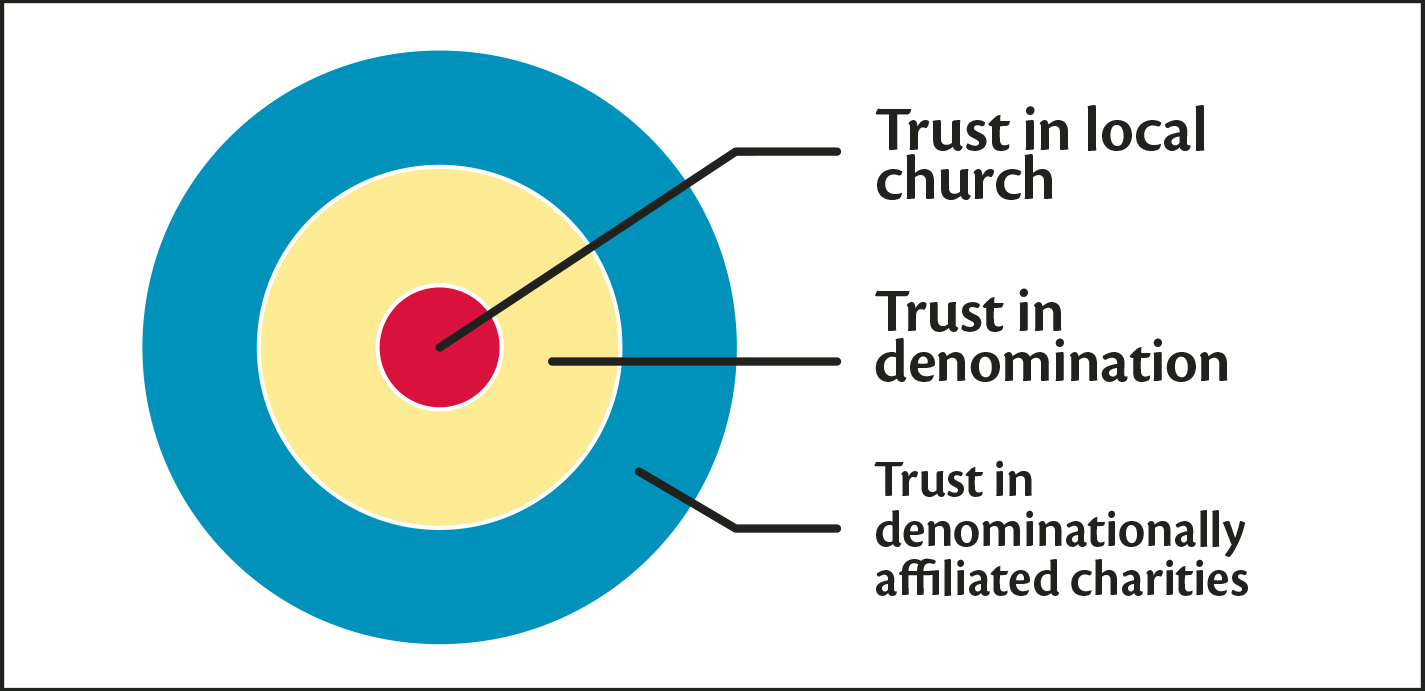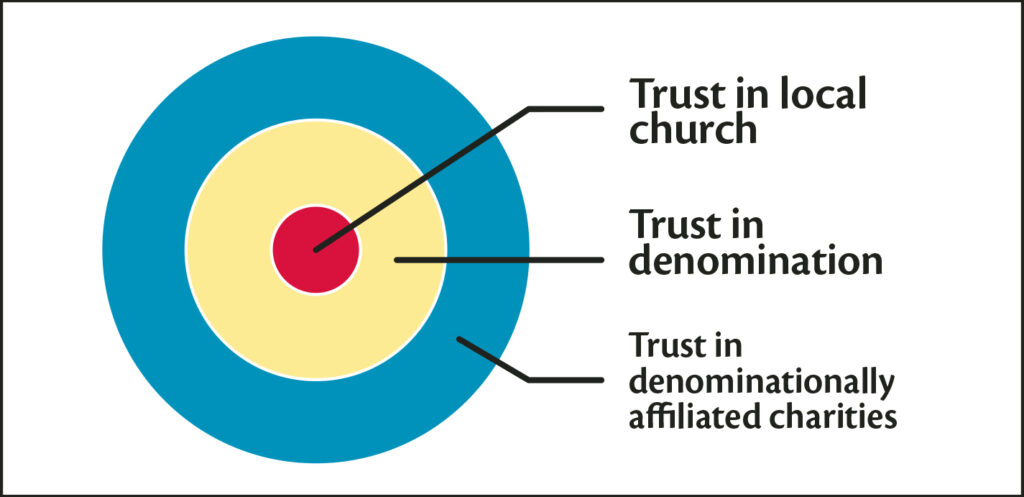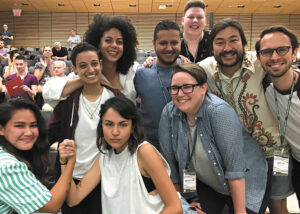Peach Blossom Church almost always meets its budget, although some years involve more drama than others. It still engages a full-time pastor, fixes the roof and supports mission workers. In 15 minutes, it can raise $5,000 to send the youth group on a mission trip.
But lately it hasn’t been giving as much money to the denomination. Nor have its individual members. So, why is this? It seems the good folks at Peach Blossom, like many other Canadian Christians, trust their local church more than they trust their denomination.
There are some loyal champions of the national church, but here is a sampling of what people say about Peach Blossom:
- “You’re closer to it.”
- “It’s easier to look and see what’s going on.”
People feel most familiar with their local church, but with respect to the denomination they say:
- “The farther away you are from the group . . . the harder it is be sure that what’s going on is what you agree with.”
- “I don’t feel I know anything about what the denomination does.”
While Peach Blossom is a fictional composite based on
churches I have met in my research, the quotes are real. (When I say ‘my research’ I’m referring to my doctoral ministry research on Canadian Christian giving, research supported by the Mennonite Foundation of Canada. See my website at lgreesor.com for more detailed results.)
Declining trust in denominations is not just a Mennonite trend. People who trust more, give more. According to a Statistics Canada report on 2014 tax filers, the typical Canadian donor gives $280 a year. At Peach Blossom, there are people who give more than that each month just to the church, and they support other causes as well. Statistics Canada tells us that the top 10 percent of donors give 66 percent of the money received by all charitable causes.
What are some hallmarks of the top 10 percent donors? They are more likely to attend worship services weekly and to trust charities, especially the local church. Trust diminishes as distance from the local church increases. (See chart above.)
People give where they feel a connection to an organization, and the national church is only one possible connection. At Peach Blossom, there is a couple who serves with an independent mission agency, not the denominational agency. This difference doesn’t matter because the husband grew up at Peach Blossom; their connection is to Josh and his family, rather than to the mission agency itself. Individuals at Peach Blossom support an astonishing range of charities—much broader than the short list of causes that they can agree on in the church budget.
Christian giving patterns are less focussed on the denomination. One older donor noted sagely that younger donors “are more interested in what the group is doing than what the group is.” Not surprisingly, it is the oldest generation that is the most loyal to the denomination.
But attendance and levels of trust in the local church are also declining. Given that churches are typically wary of asking individuals for money, while secular charities are not, the trend does not look promising for churches. Church leaders would do well to pay attention to issues of declining trust, since what is happening to the national church now could happen to the local church in the future. At Peach Blossom, they are being intentional about wills and planned giving. They have a plan for future ministry so that donors know that their bequest will benefit the church, instead of causing disputes about how to use the money.
Donors: Are they horses or cows?
Too often “you give because you should give” is the unsaid expectation for Christian giving. Churches and Christian charities frequently treat donors like cows. Donors are expected to give, but no explanation is given. But donors are more like horses; training and relationship must come first. Trust must be earned, and building a connection with the donor is essential.
I frequently quote the donor who said, “Testimony is a stronger motivator than guilt.” Relying on obligation to motivate giving is ineffective. Canadian sociologist Reginald Bibby notes that giving based on need and obligation (cows) is declining, while giving based on personal connection and vision (horses) is increasing.
At Peach Blossom, congregants used to give to their denomination because they felt they should, but the “should” argument carries less weight than in years gone by. The most compelling vision of what God is doing in the world comes from people who share their stories and testimonies with the congregation, so it’s essential for charities and national church staff to visit as many churches as possible.
Fifty years ago, most people at Peach Blossom lived and worked in the community. They did not need to talk about generosity or giving much at all, because you could see how people helped each other. Mrs. Alton learned giving from watching her dad count out money into a church pile on the kitchen table every payday. Those days are gone. The church needs to teach giving and talk about stewardship in ways it didn’t need to do before.
Generosity lessons for the church
Many donors in my research lamented the absence of stewardship teaching in their churches, and they had practical suggestions for how the church can cultivate the spiritual discipline of generosity. Hence, my advice to church leaders:
- Say thanks.
- Pay attention.
- Tell stories.
The ‘gratitude gap’
In my research I also discovered a “gratitude gap.” The local church is least likely to thank donors for their donations as compared to other types of charities. It seems ironic that the institution with a theology of giving in gratitude for God’s grace does not model grateful behaviour as well as secular institutions do.
The local church—donors’ most trusted institution—appears to be taking donors for granted. The “gratitude gap” reminds churches that other charities express thankfulness better.
Sometimes people, usually older people who give more from duty and obligation, object and say that the church does not need to say thank you. Different generations may require different approaches. For example, seniors who voice concerns about wasting money on postage for a thank-you letter could receive a personal phone call. Givers are increasingly motivated by a sense of connection and shared vision: Gratitude helps nurture generosity and builds that connection.
One donor noted that churches “issue a receipt at the end of January and a nice little form thank-you letter, and that’s it.” Another donor commented on the church bulletin, which gives financial and budget updates, “but it never says thank you for what you gave. And I think that should be added.” I agree!
Gratitude is an effective fundraising practice, but more importantly, gratitude reminds us of God’s generosity to us. It’s impossible to be too grateful: Thank God for donors, thank people and congregations who give, thank volunteers. Gratitude is foundational to giving.
Pay attention
Gratitude requires acknowledging givers. It is also necessary to pay attention to who does not give. The book Passing the Plate: Why American Christians Don’t Give Away More Money states that at least 20 percent of self-identified American Christians do not give at all.
The deacons at Peach Blossom decided that the pastor should “at least have some information about giving patterns and so forth,” in order to help with counselling people and “ask what’s happening in their lives.” An abrupt change in giving patterns could mean job loss, separation/divorce or problems at church, among others. The pastor had an enlightening discussion with the church treasurer about giving patterns. It resulted in some meaningful pastoral care opportunities, with outcomes far beyond the lines of a church budget.
Tell stories
Stories build trust and connect the donor to the cause. Peach Blossom takes time before the offering to testify about what God is doing in its midst. It’s kept simple: “We thank God for generous donors who pay to heat the church and keep the lights on throughout the week. A young mom came to the church office on Tuesday and we were able to . . . .”
Stewardship consultant J. Clif Christopher gives a number of practical suggestions in his book Not Your Parents’ Offering Plate. People give to causes, not to budgets, and stories remind people why the church or denomination exists.
And Christian and other charities need to tell their stories differently than local churches because they are farther removed from donors. It is easy for those immersed in Christian agencies to assume that people in the pews know what their organization does. They don’t.
Charities need to spend money on telling the stories of how they make a difference, so that donors will support their shared vision and values. Communicating with donors is neither a luxury, nor a frill—it’s discipleship, a ministry of encouraging generosity.
In conclusion
I’m grateful to the many people who shared their stories with me. To sum up, I say: “Trust is everything. Tell stories to build your shared vision and values. Donors give where they have connections, and they are most familiar with their local church. Don’t treat donors like cows who are expected to give without knowing why they should give. Instead, treat donors like horses, with whom you need to cultivate a relationship and point towards the finish line of a common goal. Don’t assume donors know how to give or know what you do. Practise what you preach on gratitude. Christians give in grateful response to God’s grace, so say thank you.”
In these fearful times, building trust, telling stories of God’s goodness and being grateful are more than merely fundraising advice. When we are grateful, we loosen our grip and our fear recedes. We recognize God’s grace given to us and realize we can always afford to be generous.
Lori Guenther Reesor attends Hamilton (Ont.) Mennonite Church and blogs about fundraising and theology at lgreesor.com. See more of her writing on generosity at “Join the Big Hearts Club.”
For discussion
1. What motivates you to contribute to the church? Do younger people have different motivations and giving patterns than older people? When do you hear stories about what the church does with your donations? What is today’s attitude toward tithing?
2. Lori Guenther Reesor talks about treating donors like cows or like horses. What does it mean to treat a donor like a cow? Should members of the church regard giving as an obligation? Do you agree that levels of trust in the local and broader church are declining?
3. How do you decide which charities or church agencies you will support? Is giving to the church a top priority? What about church-related agencies? Should your congregation do more to train its people in charitable giving? Should congregations do a better job of thanking their donors?
4. Reesor says that communicating with donors and telling stories of how a charity makes a difference are not luxuries—but duties—of charities so donors can share in the vision. Do you agree? What is the most effective way to tell these stories?
—By Barb Draper







Leave a Reply
You must be logged in to post a comment.